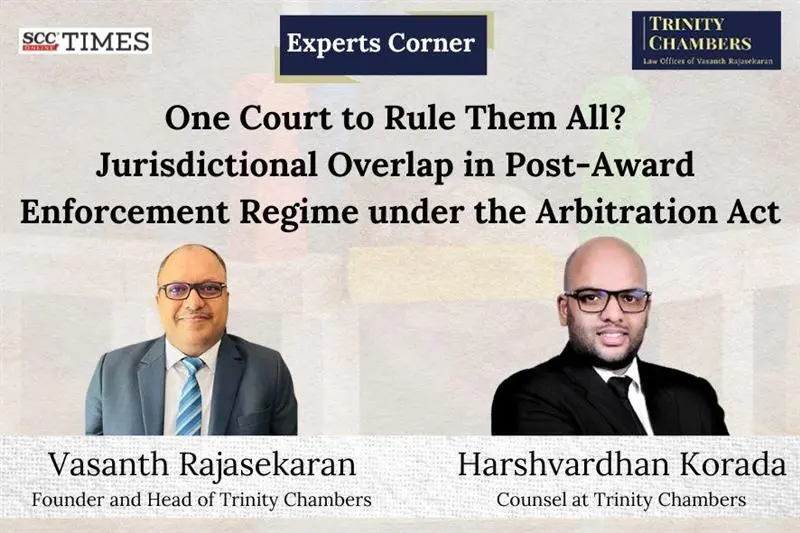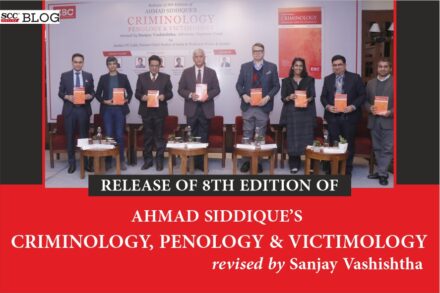Introduction
Under Indian law, the enforcement of a domestic arbitral award, which is ideally the final step in the life cycle of an arbitration, is governed by Section 36 of the Arbitration and Conciliation Act, 19961 (Arbitration Act). Section 36 introduces a legal fiction by stipulating that an arbitral award shall be enforced in the same manner as a decree of the civil court under the Civil Procedure Code, 19082 (CPC). Going by the provisions contained in Section 36 of the Arbitration Act one would reasonably infer that a court would be guided by the principles analogous to those contained in the CPC for execution of a decree.
The difficulty, however, arises when Section 36 is juxtaposed with Section 423 of the Arbitration Act. The latter of the two provisions begins with a non obstante clause superseding any other provision in Part I of the Arbitration Act or any other law. It mandates that once an application is preferred before a court with respect to an arbitration agreement under Part I of the Arbitration Act, all subsequent applications arising out of that agreement and the arbitral proceedings must be submitted exclusively to that same court only.
While the statutory object of Section 42 of the Arbitration Act is to avoid conflicting rulings from different courts and streamline the arbitral process,4 its application to enforcement proceedings under Section 36 has remained the subject of interpretive debate. This tension stems from the divergent judicial treatment of whether enforcement proceedings under Section 36 qualify as “subsequent applications” arising out of the arbitration agreement or arbitral proceedings, thereby attracting the jurisdictional bar under Section 42 of the Arbitration Act. A strict and literal reading of Section 42 would suggest that even execution proceedings must be filed before the court, which entertained the first application under Part I. However, a competing view indicates that once an award is rendered and arbitration proceedings have concluded in terms of Section 325 of the Arbitration Act, enforcement being a distinct post-arbitral remedy under the CPC ought not to be circumscribed by Section 42 of the Arbitration Act.
The dichotomy in interpretation appears to have been addressed in parts over a series of Supreme Court decisions.
In State of W.B. v. Associated Contractors6, the Supreme Court, while taking a broader view, held that all applications under Part I, whether pre or post-award, must be filed with the same Court where the first application was filed in terms of Section 42 of the Arbitration Act. One of the conclusions in Associated Contractors case7 reached by the Supreme Court read that “Section 42 will apply to applications made after the arbitral proceedings have come to an end provided, they are made under Part I”.
Subsequently, in Sundaram Finance Ltd. v. Abdul Samad8, a Coordinate Bench of the Supreme Court took the view that Section 42 had no bearing on enforcement proceedings and that an award could be executed anywhere within the country without recourse to the supervisory court under Part I.
The Supreme Court explained this position by observing that in terms of Section 32 of the Arbitration Act, arbitral proceedings are terminated upon the making of a final arbitral award. Consequently, when an award is presented for execution, the arbitral proceedings are already concluded, rendering Section 42 irrelevant. Notably, the Supreme Court in Sundaram Finance case9 did not consider the judgment rendered in Associated Contractors case10.
After the above two decisions, the issue once again appears to have cropped up for consideration in Cheran Properties Ltd. v. Kasturi and Sons Ltd.11 Although the Supreme Court referred to both the earlier decisions in Associated Contractors case12 and Sundaram Finance case13, the Supreme Court appears to have sided with the view taken in Sundaram Finance case14.
In the absence of an authoritative resolution of the issue, the divergence in judicial interpretations has created significant procedural uncertainty across High Courts for parties seeking enforcement of arbitral awards. While some courts insist on routing enforcement proceedings through the Court identified under Section 42, others uphold the autonomy of executing courts based on the legal fiction provided in Section 36 of the Arbitration Act.
This article examines the legal framework and interpretive issues surrounding Sections 36 and 42 of the Arbitration Act.
Associated Contractors: A broader view
In Associated Contractors case15, the Supreme Court was considering whether a Section 34 petition to set aside an arbitral award could be instituted before a court different from the one that had earlier been approached for interim relief under Section 916 of the Arbitration Act.
The key issue was whether Section 42 of the Arbitration Act restricts jurisdiction by mandating that all subsequent applications under Part I must be filed exclusively in the Court initially approached, and if this restriction applies, what is the scope and extent of such limitation?
The Supreme Court interpreted the provision expansively, stating that it applies to “all applications made whether before, during or after the arbitral proceedings under Part I of the Arbitration Act”. This construction was predicated on the statutory language that begins with a non obstante clause, thereby overriding other laws that may otherwise confer concurrent jurisdiction including the CPC. The Supreme Court rejected a narrow reading of the phrase “subsequent applications”, holding that Section 42’s scope is not limited to applications filed prior to the constitution of the Arbitral Tribunal or during its pendency. It made clear that the provision also governs post-award applications so long as they fall within the confines of Part I.
While the Supreme Court was scrupulous in anchoring its analysis within Part I of the Arbitration Act, it refrained from expressing any view on whether enforcement (treated as execution akin to a civil court’s decree) could also be considered a “subsequent application” for the purposes of Section 42. This silence, though perhaps intentional given the facts of the case, has become fertile ground for interpretive debate.
Sundaram Finance: Enforcement beyond Section 42
The Supreme Court’s decision in Sundaram Finance case17 countered the expansive interpretation of Section 42 advanced earlier in Associated Contractors case18. Sundaram Finance case19 carved out enforcement under Section 36 as a distinct procedural stage governed solely by the CPC. In doing so, the decision implicitly rejected the notion that the jurisdictional bar in Section 42 extends to the post-award enforcement phase.
In Sundaram Finance case20, the factual matrix was relatively straightforward. An arbitral award-holder sought execution proceedings directly before a civil court with territorial jurisdiction over the award debtor’s assets, bypassing the Court associated with the arbitration process itself. While the executing court allowed such execution, the Madhya Pradesh High Court reversed that decision, insisting that the execution petition must be routed through the Court that would have jurisdiction under the Arbitration Act in terms of Section 42. The Supreme Court, however, disagreed and reversed the High Court’s verdict, emphasising on the autonomy of execution proceedings from the earlier arbitral proceedings.
In essence, the Supreme Court opined that enforcement proceedings under Section 36 of the Arbitration Act operate independently of the arbitral process, as the arbitration proceedings stand concluded upon the pronouncement of the award. Once the award attains finality, enforcement proceedings cease to be arbitral in character, transforming instead into ordinary civil proceedings guided by the CPC.
While Sundaram Finance case21 directly dealt with the issue, it failed to engage with or distinguish the earlier decision in Associated Contractors case22.
Cheran Properties
After the decisions in Associated Contractors case23 and Sundaram Finance case24, the question of jurisdictional constraints under Section 42 in the context of enforcement proceedings resurfaced in Cheran Properties case25. While the central issue in Cheran Properties case26 concerned whether an arbitral award could be enforced against a non-signatory, the Supreme Court’s approach to enforcement carried important implications for Section 42. Upon reviewing both the decisions in Associated Contractors case27 and Sundaram Finance case28 the Supreme Court appears to have sided with the latter by stating the following:
40. Consequently, in the view of the Court, the enforcement of an award through its execution can be initiated anywhere in the country where the decree can be executed and there is no requirement of obtaining a transfer of the decree from the court which would have jurisdiction over the arbitral proceedings.29
High Courts’ interpretative responses to Supreme Court decisions
The interpretation of Sections 36 and 42 of the Arbitration Act has generated considerable jurisprudential complexity, leading to divergent approaches across various High Courts. A closer analysis reveals that the High Courts have either relied on or distinguished these decisions, often influenced by differing views on arbitral autonomy, procedural efficiency, and the fundamental objectives of the Arbitration Act.
(a) Allahabad High Court
In Madhyanchal Vidyut Vitran Nigam Ltd. v. Shashi Cable30, the Allahabad High Court was faced with a challenge to the territorial jurisdiction of the commercial court at Lucknow for executing an arbitral award rendered in Kanpur. The petitioner contended that Section 42 barred execution outside Kanpur, being the Court first approached under Part I. Relying heavily on Associated Contractors case31, the petitioner argued that all proceedings arising from the arbitration agreement, including enforcement, must follow the first forum.
Rejecting this contention, the Supreme Court drew extensively on the rationale of Sundaram Finance case32, noting that Section 42 applies only to proceedings under Part I and loses relevance once the arbitral proceedings terminate under Section 32 of the Arbitration Act. The High Court observed:
12. The executing court having jurisdiction to execute the award can be any court anywhere in the country, where the decree can be executed and thus in view of the law expounded in Cheran Properties case33, I have no hesitation in holding that the objection of the petitioner that the Court at Lucknow had no jurisdiction loses its relevance and is worthy of rejection.34
Similarly, in NHAI v. Jagpal Singh35, the Allahabad High Court reinforced the view that execution need not be routed through the Court seized of the original arbitration proceedings. Here again, the objection to territorial jurisdiction was overruled on the dual grounds that: (i) Section 42 does not apply post-termination of arbitral proceedings; and (ii) the petitioner had voluntarily invoked the jurisdiction of the executing court under Section 34, thereby waiving objections under Section 436 of the Arbitration Act.
Taken together, these decisions represent a coherent and assertive endorsement of the view taken in Sundaram Finance case37, placing execution outside the purview of Section 42. The Allahabad High Court treats enforcement as a distinct post-award remedy governed by the CPC, free from the arbitral process’s supervisory jurisdiction.
(b) Delhi High Court
While the Delhi High Court has been mindful of the jurisdictional discipline envisioned by Section 42, it has simultaneously embraced the functional distinction between arbitral proceedings and enforcement in line with the decision in Sundaram Finance case38.
In Rama Civil India Constructions (P) Ltd. v. Union of India39, the award debtor resisted enforcement on the ground that a challenge under Section 34 had earlier been preferred before the commercial court situated at Dehradun, and therefore, the enforcement petition filed in Delhi was barred under Section 42 of the Arbitration Act. The Delhi High Court, however, rejected this jurisdictional challenge and held as below:
10. The Court, however, finds itself unable to sustain the aforesaid submission bearing in mind the fact that Section 42 of the Arbitration Act prescribes where applications under the aforesaid part have been preferred or be pending before a court, all subsequent applications would have to be filed before the same court. In the considered opinion of the Court, the appeal which has been instituted before the Uttarakhand High Court would clearly not fall within the ambit of the aforesaid section.
11. The said provision relates to applications filed under the aforesaid part. The issue even otherwise appears to stand concluded in light of the decision rendered by the Division Bench of the Court in Vijay Gupta v. Renu Malhotra40,where it was held that the venue restriction provision as contained in Section 42 of the Arbitration41
Notably, in Vijay Gupta case42, the High Court had held that there an execution application is neither “arbitral proceedings” within the meaning of Section 42 of the Arbitration Act nor a “subsequent application” arising out of the agreement.
In one of the most thorough examinations of the tension between Sections 42 and 36 of the Arbitration Act, the Delhi High Court in Gujarat Jhm Hotels Ltd. v. Rajasthali Resorts and Studios Ltd.43, categorically reinforced the autonomy of executing courts and clarified that Section 42 has no bearing on post-award enforcement proceedings. In Gujarat Jhm Hotels Ltd. case44, a commercial court in Jaipur had kept an execution petition in abeyance, relying on the Rajasthan High Court’s decision in Ess Kay Fincorp Ltd. v. Suresh Choudhary45, which had held that execution petitions should be routed through the seat Court in view of the decision in Associated Contractors case46. This led the decree-holder to approach the Delhi High Court for enforcement.
The High Court unambiguously held that enforcement proceedings were not confined by the rigours of Section 42 of the Arbitration Act and could be filed anywhere in the country.
The High Court at the outset referred to the decision in Daelim Industrial Co. Ltd. v. Numaligarh Refinery Ltd.47 Decided almost a decade before the Supreme Court’s verdict in Sundaram Finance case48, the High Court in Daelim case49 opined as below:
16. The execution application is not “arbitral proceedings” within the meaning of Section 42 of the Arbitration Act and is not a subsequent application arising out of the agreement and the arbitral proceedings. In fact, the arbitral proceedings come to an end when the time for making an application to set aside the arbitral award expires and the execution application is an enforcement of the award. Thus, the place of filing of the execution application need not be the place of the filing of the application under Section 34 of the Arbitration Act for the reason of Section 42 of the Arbitration Act.
The decision in Daelim case50 came to be affirmed in a Division Bench decision of the High Court in Union of India v. Atlanta Ltd.51 and subsequently also in Sundaram Finance case52.
Speaking of the two decisions rendered in Associated Contractors case53 and Sundaram Finance case54, the High Court opined that it failed to find any irreconcilable or discordant note between the two decisions. As per the High Court, the decision in Sundaram Finance case55 only appeared to recognise the limited extent to which the legal fiction enshrined in Section 36 of the Arbitration Act would extend. In other words, apart from the Court, as under Section 42 of the Arbitration Act, a party seeking execution of an award would also have the choice to initiate proceedings in a court within whose jurisdiction the assets of the award debtor may be situated.
As would be noted above, the Delhi High Court has consistently taken the view that enforcement of arbitral awards under Section 36 of the Arbitration Act stands outside the ambit of Section 42. Through a series of decisions culminating in Gujarat Jhm Hotels Ltd. case56, the High Court has drawn a clear doctrinal line between arbitral proceedings governed by Part I of the Arbitration Act and post-award enforcement proceedings governed by the CPC. It has interpreted Sundaram Finance case57 and Associated Contractors case58 as operating in distinct procedural spheres, with no conflict between them.
(c) Telangana High Court
The Telangana High Court, unlike some of its counterparts, has taken a restrictive view on the issue of post-award enforcement jurisdiction, consistently reaffirming the controlling effect of Section 42 even at the execution stage. Two decisions in India Media Services (P) Ltd. v. SBPL Infrastructure Ltd.59 and Pipeline Infrastructure Ltd. v. Nagarjuna Fertilizers and Chemicals,.60 form the backbone of the position laid by the Telangana High Court.
In India Media Services case61, the Division Bench of the Telangana High Court was called upon to decide whether the execution of an arbitral award could be entertained by a civil court in Hyderabad when the arbitral proceedings, including applications under Sections 9 and 34, had all been carried out before the Calcutta High Court. The Hyderabad Court had allowed the execution petition, but the Division Bench reversed this, holding that Section 42 mandates jurisdictional exclusivity in favour of the Court first approached under Part I of the Arbitration Act. The High Court placed heavy reliance on Associated Contractors case62, emphasising the Supreme Court’s conclusion that Section 42 applies to all applications “pre, during, or post-award” so long as they fall within Part I.
The High Court reviewed the later judgments of the Supreme Court in Sundaram Finance case63 and Cheran Properties case64, but held that these were distinguishable. It concluded that Sundaram Finance case65 was rendered in a factual matrix where no application under Section 9 or Section 34 had been filed thereby making Section 42 inapplicable. In contrast, in India Media Services case66, both interim relief and challenge to the award had been instituted before the Calcutta High Court. As such, the High Court ruled that the Hyderabad Court lacked jurisdiction to entertain the execution petition.
In Pipeline Infrastructure case67, the Telangana High Court revisited the same issue. Here, the arbitral award was passed in Bombay and was under challenge before the Bombay District Court under Section 34. Meanwhile, the award-holder initiated execution proceedings in Hyderabad. The commercial court in Hyderabad dismissed the execution petition on the basis of the Division Bench ruling in India Media Services case68. The decree-holder challenged this dismissal in revision proceedings. However, the Telangana High Court refused to interfere, affirming that the commercial court had rightly relied upon the binding precedent in India Media Services case69.
Significantly, the High Court rejected the argument that Sundaram Finance case70 and Cheran Properties case71 had overruled Associated Contractors case72. It reasoned that both later decisions were distinguishable in facts and scope. The High Court reiterated that Section 42 “sweeps under its carpet” all other provisions dealing with execution and that only the Court approached under Section 9 or Section 3473 of the Arbitration Act could exercise jurisdiction over enforcement.
Thus, the Telangana High Court has unequivocally adopted a jurisdiction-centric interpretation of the Arbitration Act, tethering execution proceedings to the supervisory court identified under Section 42. While the approach reinforces procedural coherence, it arguably narrows the functional autonomy of enforcement courts and may undermine the objective of swift execution envisaged in Sundaram Finance case74.
Conclusion
The legal conundrum arising from the intersection of Sections 36 and 42 of the Arbitration Act continues to cast a long shadow over the finality and enforceability of domestic arbitral awards in India. While Section 36 clearly renders an award enforceable “as if” it was a decree of a civil court, thereby importing the execution framework of the CPC, Section 42 introduces a jurisdictional restriction that has been interpreted inconsistently across courts. The crux of the dispute lies in whether enforcement under Section 36 is to be treated as a “subsequent application” within the meaning of Section 42, thereby compelling award creditors to approach the Court first seized under Part I of the Arbitration Act, or whether enforcement, as a post-arbitral civil remedy, lies beyond the supervisory jurisdiction envisaged under Section 42.
The Supreme Court’s rulings in Associated Contractors case75 and Sundaram Finance case76 have provided partial answers. While Associated Contractors case77 adopted a broad and textually literal reading of Section 42, extending it to all Part I applications including post-award ones, it stopped short of expressly pronouncing on enforcement. Sundaram Finance case78, on the other hand, emphatically held that execution proceedings are not governed by Section 42, since they arise after arbitral proceedings have concluded under Section 32. The Supreme Court’s silence in Sundaram Finance case79 on Associated Contractors case80, despite the apparent divergence in approach, has only intensified the lack of clarity, especially in the absence of an authoritative ruling. Cheran Properties case81, while not directly addressing the conflict, leaned in favour of Sundaram Finance case82 by recognising that enforcement may be initiated before any competent executing court without recourse to the supervisory court.
This judicial ambivalence has percolated into the High Courts. While the Delhi and Allahabad High Courts have coalesced around the reasoning in Sundaram Finance case83, emphasising on the autonomy and decentralisation of execution, the Telangana High Court has reaffirmed a strict commitment to Associated Contractors case84, insisting that execution must follow the supervisory court first approached under Part I. The Delhi High Court, in particular, through Gujarat Jhm Hotels Ltd. case85, has made significant strides in reconciling the two Supreme Court decisions by interpreting them as operating in separate procedural domains i.e. Associated Contractors case86 for Part I applications and Sundaram Finance case87 for post-award execution. This approach reflects the more pragmatic reading of the statutory scheme.
However, this divergence has real and adverse consequences. Award creditors continue to face jurisdictional objections, procedural delays, and conflicting directions from courts. In some instances, executing courts have refused to entertain enforcement petitions, forcing parties to first approach the supervisory court for a transfer, only for that court to send them back to the executing court. Such a jurisdictional merry-go-round not only undermines the efficiency of the arbitral process but also threatens to dilute the commercial value of arbitral awards.
In this context, the law stands at a critical crossroads. Unless the Supreme Court definitively clarifies the scope of Section 42 in relation to enforcement proceedings, the risk of conflicting decisions and procedural uncertainty will continue to loom large. Given the increasing reliance on arbitration in commercial disputes, and the avowed legislative aim of making India an arbitration-friendly jurisdiction, this uncertainty in the enforcement regime is deeply counterproductive. A larger Bench of the Supreme Court must take up the issue to decisively pronounce whether Section 42 governs enforcement proceedings under Section 36. Until then, clarity will remain elusive, and arbitral awards, though final on paper, may remain practically unenforceable.
*Head and Founder, Trinity Chambers.
**Counsel, Trinity Chambers.
1. Arbitration and Conciliation Act, 1996, S. 36.
2. Civil Procedure Code, 1908.
3. Arbitration and Conciliation Act, 1996, S. 42.
4. BGS SGS SOMA JV v. NHPC Ltd., (2020) 4 SCC 234.
5. Arbitration and Conciliation Act, 1996, S. 32.
16. Arbitration and Conciliation Act, 1996, S. 9.
29. (2018) 16 SCC 413, 441.
36. Arbitration and Conciliation Act, 1996, S. 4.
60. C.R.P. Nos. 3603 & 3606 of 2023.
67. C.R.P. Nos. 3603 & 3606 of 2023.






